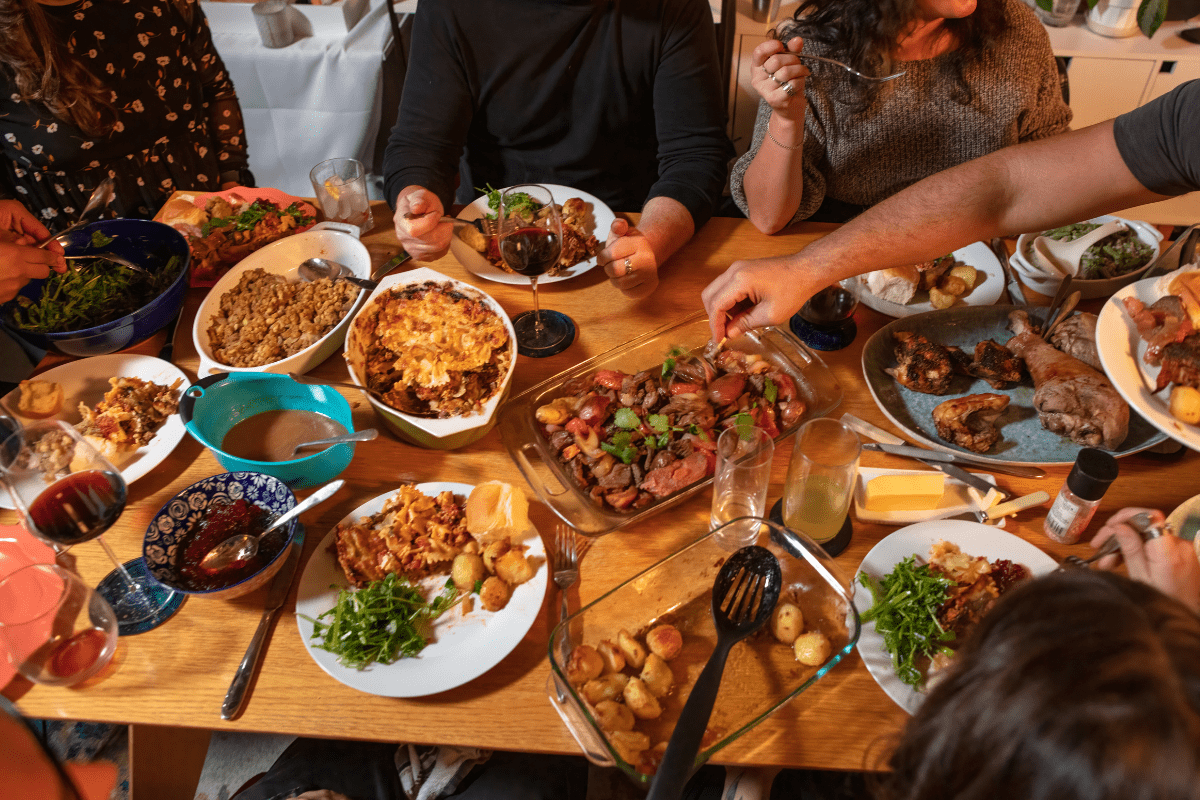Ever wonder why Oklahoma is the only state with an official meal featuring 13 different dishes? Or how Depression-era penny-pinching created one of America's most beloved burgers? Welcome to Oklahoma's wild culinary landscape, where cowboy cooking meets Vietnamese pho and fried onion burgers share menu space with James Beard Award-winning fine dining.
The only state with an official menu (and proud of it)
Picture this: In 1988, Oklahoma legislators sat down and did something no other state has done before or since. They officially designated a 13-dish state meal that reads like your grandmother's Sunday spread on steroids. We're talking chicken-fried steak, barbecued pork, fried okra, cornbread, biscuits, AND grits… because why choose when you can have it all?
This governmental food flex actually makes perfect sense when you understand Oklahoma's position as America's culinary crossroads. With 39 Native American tribes (more than any other state), waves of European immigrants, and its location where the South meets the Southwest meets the Midwest, Oklahoma became a melting pot where food traditions didn't just coexist… they got married and had delicious babies.
What's actually on that famous state meal
Here's the full lineup that makes Oklahomans' hearts sing:
- Chicken-fried steak (the undisputed star)
- Barbecued pork
- Sausage and gravy
- Fried okra
- Squash
- Cornbread
- Biscuits
- Grits
- Corn
- Black-eyed peas
- Strawberries
- Pecan pie
- (Mysteriously, no official drink)
Each dish tells a story. The Three Sisters crops (corn, beans, squash) honor Native American agricultural wisdom. Fried okra and black-eyed peas? Thank the African Americans who brought soul food traditions after the Civil War. And that chicken-fried steak? That's German and Austrian immigrants saying "hey, what if we made schnitzel, but with cheap beef?"
Born in desperation, perfected in El Reno
Speaking of making do with what you've got, let me tell you about Oklahoma's greatest contribution to burger science: the fried onion burger. During the Great Depression, when beef cost more than most folks could afford, the owners of Hamburger Inn in El Reno got creative. They started pressing thin beef patties into mountains of sliced onions, stretching that expensive meat while creating something magical.
How to spot an authentic fried onion burger
The technique hasn't changed at El Reno's holy trinity of burger joints: Sid's Diner, Robert's Grill, and Johnnie's Grill. Here's what happens:
- Quarter-pound beef ball hits scorching griddle
- Paper-thin white onions pile on immediately
- Everything gets smashed together with gusto
- Onions caramelize into the beef
- Simple bun, mustard, pickles finish it
No fancy toppings. No aioli. Just beef, onions, and Depression-era ingenuity creating something so good that El Reno now hosts an annual festival where they make an 850-pound version. Because Oklahoma.
The frybread paradox: Tragedy turned treasure
Here's where things get complicated and beautiful at the same time. Indian tacos, served on golden frybread instead of tortillas, represent both heartbreak and hope in Oklahoma's food story. Created from government rations during the forced relocations of the 1860s, frybread emerged when traditional foods weren't available and people had to survive on flour, salt, and lard.
Today, this survival food has transformed into something else entirely. At powwows and the National Indian Taco Championship in Pawhuska, frybread is celebration food. Modern Native American chefs are doing incredible things with traditional ingredients too. Check out Thirty Nine Restaurant at Oklahoma City's First Americans Museum, where indigenous cuisine gets the respect and innovation it deserves.
Making traditional frybread (harder than it looks)
The basic recipe seems simple: flour, baking powder, salt, and warm water. But here's what they don't tell you:
- Too thick = raw, doughy centers
- Too thin = crispy chips, not fluffy bread
- Oil temperature matters immensely
- Stretching technique takes practice
- Every family guards their proportions
Top it with seasoned ground beef, pinto beans, lettuce, tomatoes, cheese, and sour cream, and you've got an Indian taco that'll make you understand why people drive hours for the good ones.
Cowboys, cattle drives, and cast iron traditions
Oklahoma's position along historic cattle drive routes didn't just influence the cuisine… it created an entire cooking culture. Chuck wagon cooking, invented to feed cowboys on months-long cattle drives, established traditions that Oklahoma cooks still swear by today.
Enter Kent Rollins, Oklahoma's official chuck wagon cook from Hollis, who's keeping these traditions alive on YouTube and at cowboy gatherings. This man can make a gourmet meal over an open fire with nothing but cast iron and attitude. His techniques aren't just historical curiosities either… they're legit cooking methods that work as well in your backyard as they did on the Chisholm Trail.
Why Oklahoma does chicken-fried steak differently
Here's a hill I'll die on: Oklahoma's chicken-fried steak is superior to Texas's version. Fight me. The key difference is the gravy. While Texans often go with brown gravy, Oklahomans stick with white cream gravy made from the pan drippings. It's richer, it soaks into the crust better, and it's the correct choice.
The traditional Oklahoma method involves:
- Cube steak pounded paper-thin
- Triple dredging (flour, egg, flour again)
- Cast iron frying (non-negotiable)
- Cream gravy from the drippings
- Portions that require structural engineering
Want to see this taken to extremes? Kendall's Restaurant in Noble serves a six-pound version. That's not a typo. Six. Pounds.
From oil boom to foodie boom
The discovery of oil, starting with the Nellie Johnstone well in 1897, didn't just bring wealth to Oklahoma… it brought appetites for finer things. Suddenly, former frontier towns needed restaurants worthy of oil executives' expense accounts. Cattlemen's Steakhouse, operating since 1910 in Oklahoma City's Stockyards, became the place where deals were sealed over massive steaks.
Fast forward to today, and Oklahoma's food scene is having its biggest glow-up since the oil boom. Andrew Black's Grey Sweater made history in 2023 as Oklahoma's first James Beard Award winner. Jeff Chanchaleune, a Laotian refugee turned culinary superstar, has been called "the beating heart of Oklahoma's culinary renaissance."
The new wave making national headlines
Get this: Nonesuch in OKC was named America's best new restaurant by Bon Appétit. A Michelin-starred chef took it over. In Oklahoma City. Let that sink in.
Meanwhile, Noche in Tulsa made the New York Times' 50 Best Restaurants in America list, serving Mexican and Latin fusion in the historic Greenwood District. This is the same neighborhood rebuilding from the 1921 Race Massacre, making the success even more meaningful.
Regional quirks that make sense once you're here
Eastern Oklahoma, snuggled up against Arkansas, goes hard on Southern influences. You'll find more fried catfish, stronger soul food traditions, and communities where traditional Native American dishes like wild onion dinners and grape dumplings still appear at gatherings.
Head west, and you're in serious ranching country. The chicken-fried steaks get bigger, the beef obsession intensifies, and tiny towns maintain cafes where cowboys legitimately still gather for 5 a.m. coffee. The German Mennonite influence shows up in wheat-based dishes and sausage-making traditions they brought from Russia.
OKC's Asian District (plot twist!)
Here's something that surprises visitors: Oklahoma City has a thriving Asian District with some of the best Vietnamese food between the coasts. The pho is legit, the banh mi game is strong, and the hot pot will cure whatever ails you. This started with Vietnam War refugees and has grown into a vibrant community that adds another delicious layer to Oklahoma's food story.
Oklahoma barbecue: The Switzerland of smoked meat
While other states argue about the "right" way to barbecue, Oklahoma said "yes to all of it" and created what experts call "BBQ Switzerland". We use multiple woods (hickory, oak, pecan), multiple meats (not just beef, Texas), and our sauce splits the difference between Kansas City sweet and Texas tang.
This diplomatic approach to barbecue makes sense when you realize Oklahoma sits at the intersection of all the great barbecue traditions. We borrowed the best from everyone and aren't precious about it. The result? Really good barbecue without the attitude.
Where to eat your way through Oklahoma history
Start your journey at Cattlemen's Steakhouse in the Stockyards. Order the lamb fries (don't ask, just trust) and a breakfast steak with eggs. This place has served everyone from real cowboys to presidents, and it shows.
For the ultimate fried chicken, head to Eischen's Bar in Okarche. Oklahoma's oldest bar knows exactly one way to make chicken, and they've been doing it the same way since 1896. No menu. Just "how many pieces?"
The comfort food upgrade experience
Want to see what happens when talented chefs elevate Oklahoma comfort food? Cheever's Cafe in OKC puts jalapeño cream gravy on their chicken-fried steak and serves blue cheese potato chips that'll ruin regular chips forever.
For the full Route 66 experience, stop at The Rock Cafe in Stroud. Yes, it inspired the character Sally in Pixar's "Cars." Yes, the food is actually good. Order the chicken-fried steak sandwich and embrace the absurdity.
The festivals that feed thousands
Oklahoma takes its food festivals seriously. The Oklahoma State Fair features all 13 components of the official state meal, because of course it does. The El Reno Fried Onion Burger Day Festival in May draws thousands to watch the creation of that 850-pound burger monstrosity.
But the National Indian Taco Championship in Pawhuska might be the most meaningful. Competitors from across Indian Country gather to share recipes, techniques, and stories. It's competition, celebration, and cultural preservation all wrapped in frybread.
Want to learn? Oklahoma's got you covered
If you're serious about understanding Oklahoma cuisine, consider checking out Oklahoma State University's Food Science program or OSUIT's culinary arts program. These schools are training the next generation to honor traditions while pushing boundaries.
For home cooks, Kent Rollins' website and YouTube channel offer authentic chuck wagon cooking lessons. Warning: You'll end up buying cast iron. Lots of cast iron.
The economics of eating well
Here's something to chew on: Oklahoma's agriculture generates $9.8 billion annually, with cattle alone accounting for $2.54 billion. We're talking 2.07 million beef cattle making Oklahoma the second-largest producer nationally.
The food industry employs 188,294 people and contributes $28 billion to the state's economy. Even our wine industry (yes, we have one) generates $1.29 billion in economic activity. Those numbers translate to fresh, local ingredients in restaurants and a thriving food culture that keeps evolving.
Why Oklahoma cuisine stands apart
Unlike Texas with its beef-only barbecue orthodoxy or Kansas with its purely Midwestern approach, Oklahoma embraces its multiple personalities. We're the only state with an official meal, the birthplace of the fried onion burger, and the place where chicken-fried steak gets white gravy because that's obviously correct.
Our food tells the story of survival, adaptation, and eventually, celebration. From Depression-era penny-stretching to James Beard Awards, from forced relocations to food festivals, Oklahoma's cuisine captures the American experience in all its messy, delicious complexity.
So next time someone dismisses "flyover state" food, tell them about the Laotian refugee making national headlines with his cooking. Mention the 850-pound burger. Describe the frybread that represents both tragedy and triumph. Then invite them to dinner in Oklahoma, where every meal comes with a story and second helpings are mandatory.
Because here's the thing about Oklahoma cuisine: It's not trying to be something it's not. It's comfort food that comforts. It's fancy food without the fanciness. It's tradition married to innovation, served with a side of "y'all come back now." And honestly? That's exactly what makes it perfect.




